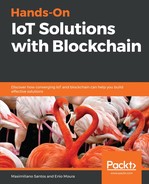The architecture described in this chapter involves many components, and the implementation may seem a little complex. By now, we've established that the combination of IoT and blockchain can mitigate several issues and transform the workings of the modern food chain. For example, such an implementation can bring transparency between members, allowing them to control data more efficiently; increase their security; make the process automatic and dynamic; remove middlemen; and make the chain less complex overall.
We also saw that IoT works as the extension of computing and network capabilities for devices and sensors, enabling them to make machine-to-machine interactions with minimal or no human input. These technological components bring advantages such as unprecedented automation, cost reduction for provisioning, energy savings, value-added services, and efficient management.
Blockchain's integration with IoT will make possible data exchange between edge devices such as sensors, barcode and QR code scan events, and RFID-based assets. Assets connected with sensors will be able to record sensitive information, such as the location and temperature of a particular warehouse, and this information could be automatically logged or updated on a blockchain.
With a better understanding of the architecture and the elements that comprise its technical components, we'll be able to fully implement a solution with IoT and blockchain for the modern food chain.
In the next chapter, we'll see how to create our own blockchain with IoT.
